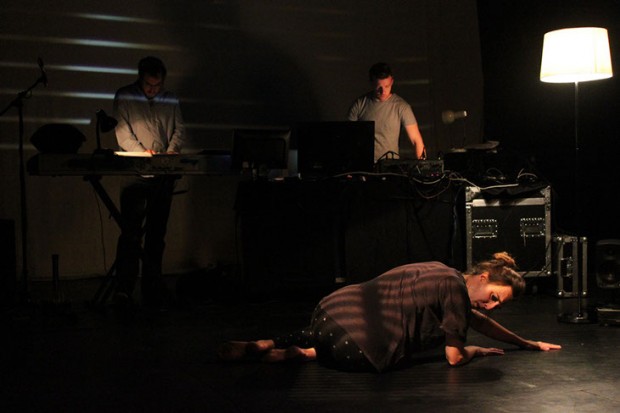You have no items in your cart. Want to get some nice things?
Go shopping
Silent Opera has been lauded for its innovative approach to opera, bringing fresh insight into the work of Monteverdi in its dockside staging of L’Orfeo, and shaking up the Aldeburgh Festival with the very contemporary feel of its performances. The Saatchi Gallery furnishes Silent Opera with its latest home, its open spaces and many levels the perfect labyrinthine setting for Live/Revive/Lament, a triptych love story with moving performers.
The concept behind the production is fascinating: each of the three themes – Live, Revive and Lament – represent a separate stage in the process of loving. “Live” signifies the euphoria at a relationship’s start, “Revive” is emblematic of the cracks that begin to emerge as the relationship progresses, while “Lament” portrays the horror of heartbreak at the end of the cycle. Each of these themes is treated by a performer working in one of three disciplines – opera, acting and dance – and, as a result, the evening behaves in rotation, a constantly turning circle of living, reviving and lamenting.
We are given a tarot card at the start of the performance, informing us of the theme with which we will begin. Live, our card reads, and we follow our guide to the top floor of the gallery where a girl (Katie Slater) is reading a book upon a bench while two men wait in the far corner, one surrounded by wires at a computer, the other sitting by an upright piano. The performance is layered: pre-recorded noises of clinking glasses and voices sound around the space, while the piano plays above it. “I see him,” Slater sings. “I want him.” Her voice is incredibly powerful, and fills the gallery through which the crowd is scattered. She moves among us, singing, at one point, by my side; she is so close that I can see the tears in her eyes.
Recorded sounds of texts read aloud, of phones ringing and voicemail messages, of Shakespearean sonnets and Dire Straits lyrics, carry the narrative from euphoria to anxiety and back again. The piano music enjoys a nineteenth century feel, before slipping – at the singer’s behest – into jazz. Although the initial impression is of busy-ness, my ears adjust to the richness of the sounds, gradually understanding the many levels upon which this story is operating. At the end of her section, Slater beckons for us to follow her – but we remain to see the scene reimagined by another performer (Jessica Butcher).
Watching the same scene interpreted in a different discipline, with the same background sounds and premise – an identical outfit, even, worn by the second actor – is an interesting experience. Details missed the first time are elucidated in the second performance. The hero for whom this lovelorn, tripartite character is longing is named Teseo, I realize, after Monteverdi’s Theseus, and the “Lament” scene draws on his Lamento d’Arianna (these borrowings make for an interesting counterpoint between the work of Monteverdi – composer of the first opera – and the modern day noises being blasted through the speakers around us). Butcher reaches a frenzy of worry, repeating Sonnet 148 (“O me! what eyes hath love put in my head,/ Which have no correspondence with true sight!”) with breathless hysteria. The proximity of her performance is remarkable; she approaches audience members to ask their opinion on her situation, and this interaction widens the scrutiny of the scene from the actor to the observers.
At the end of her performance she asks that we follow her to her new house, a great, sack-covered expanse of space on the floor below. She begins to unpack, stacking paperbacks against my knee as I watch cross-legged on the floor, and we wait for Teseo to arrive. Needless to say, he never does. Her hopes for their future (echoed comically in the recording of an estate agent’s patter about their new property) are shattered. Voices sound through the speakers around us, telling of promises made which are now broken. She asks the pianist not to perform, but the music continues. She throws sheets of music at the instrument, yet the sounds persist. It feels like a physical approximation of madness.
And now we are at the end of the evening, but able to watch the performances we missed on our smartphones, a further example of the company’s clever use of technology to broaden the range of the production. Later, I see that the final scene, “Lament”, takes place in a room dedicated to the Saatchi’s current exhibition on Pangea, filled by artist Rafael Gómezbarro with giant ants. It is a fittingly surreal home.
The production is an intelligent one, and will, I suspect, work just as effectively in other arenas (it travels to Wilderness Festival later this summer). It reimagines opera for a fringe audience, filling a gap which has been sorely overlooked in recent years. And it is powerful: the epic scale for which opera is loved is replaced, here, by the personal. The impact of a full orchestra, of a stage and an auditorium are supplanted by the very intimate power of a single performer and a pianist and the many sounds ringing in her mind.
Will it bring new audiences to opera? Perhaps. The immersiveness of the production will appeal to those tired of the rigid rows of theatre seats and carefully erected fourth wall we are too often subjected to. I’m not sure that it serves to make opera more accessible; the build-up of sounds, themes and disciplines feels more impenetrable than the linear love story of, say, La Traviata. But it is exciting, whatever it is, a welcome addition to the experimental world of fringe theatre.

About Xenobe Purvis
Xenobe is a writer and a literary research assistant. Her work has appeared in the Telegraph, City AM, Asian Art Newspaper and So it Goes Magazine, and her first novel is represented by Peters Fraser & Dunlop. She and her sister curate an art and culture website with a Japanese focus: nomikomu.com.




